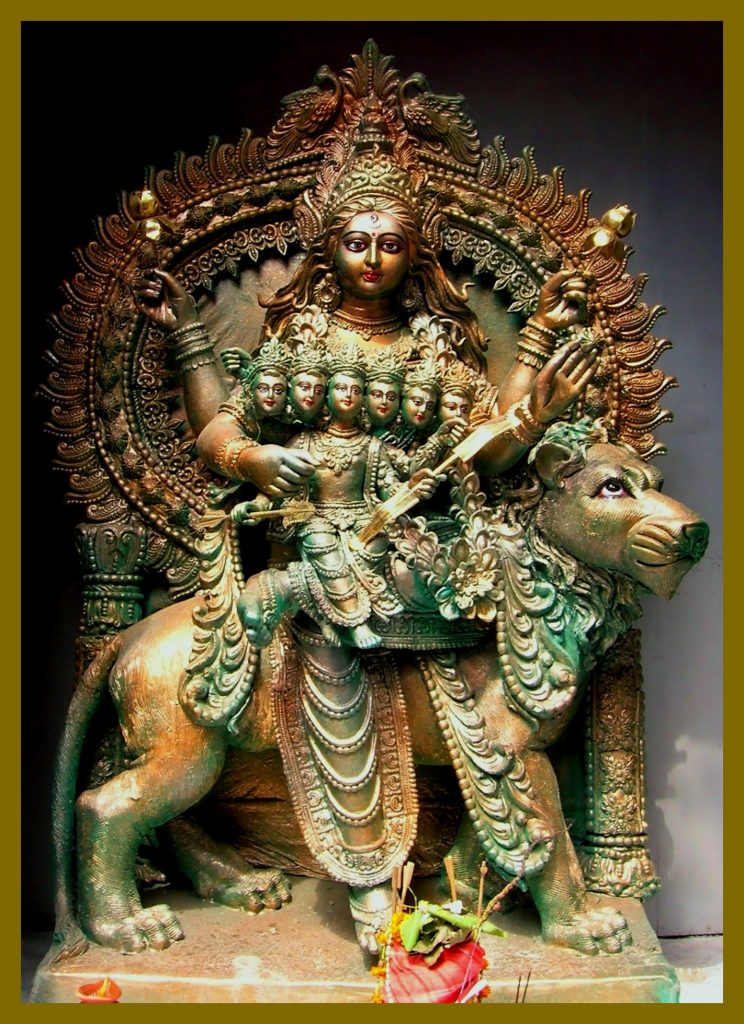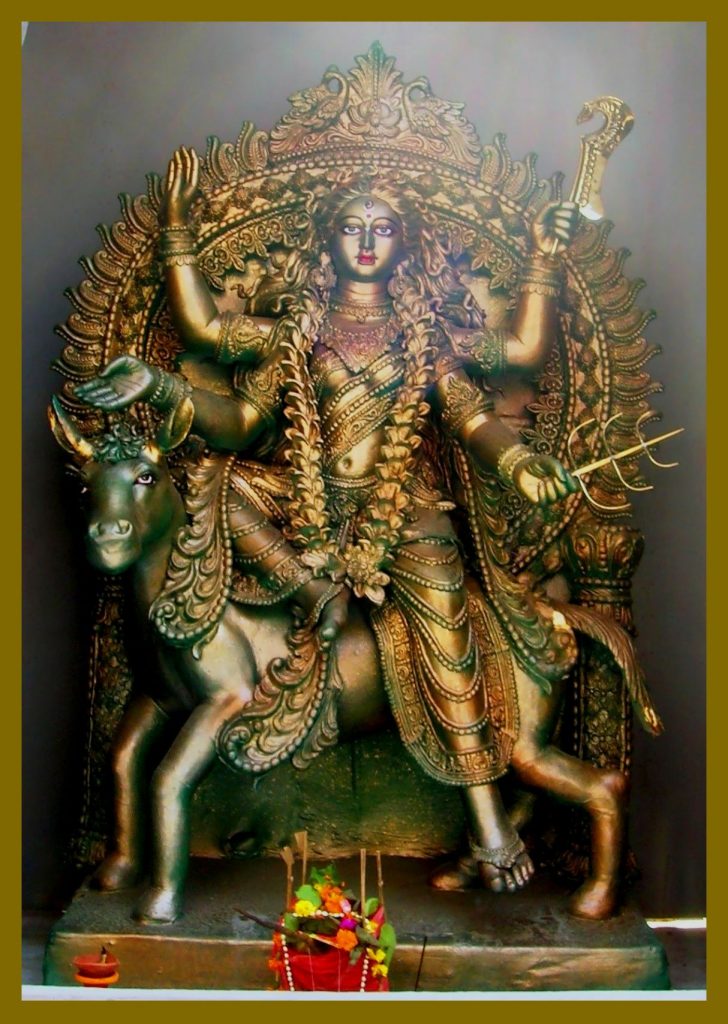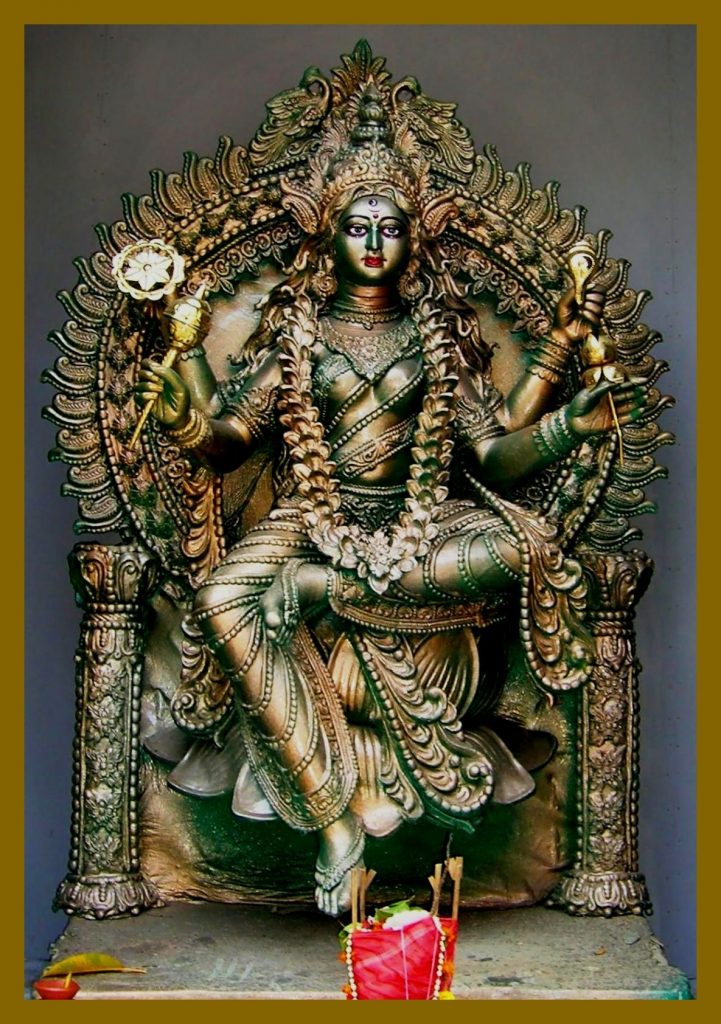
The Hindu festival of Maha Navratri comes every year by the time of Autumn. It puts a full stop on the period of pitra paksha and further showers goodness, positivity, happiness, and celebration.
These nine nights and ten days hold a prominent part of the religious beliefs of the entire country. The observation of Navrathri occurs for uncountable reasons and forms. As a matter of facts, Indians celebrate the festival for four times in a year. However, the festival of Maha Navratri has a specific eminence.
The festivity of Sharada Navratri or Maha Navratri occurs in the Hindu month of Ashvin in the honor of Divine deity Durga and her nine manifestations. With the eternal light of Diya on Nine days of Navratri, we celebrate women. Also, we celebrate her power, courage, victory, determination, focus, fondness, strength, and resolve.
Let’s dive ahead to read the origin and prominence of each Goddess we pray for nine days.
Devi Shailputri is the daughter of Parvatraj Himalaya or King of Mountain, Himalaya. She is the first form of Goddess Durga. Also, the ceremony of the nine-day long festivity commences with the Pooja or worship of Goddess Shailputri.

According to Hindu religion and sacred writings, she takes birth as Devi Shailputri after her first birth in the form of Devi Sati who sacrifices her life because of her father insults her husband Lord Shiva. She rides a bull with a Trishul in the right hand and a lotus in her left hand.
Devi Shailputri is the embodiment of the holy trinity Brahma, Vishnu, and Shiva. In the tales, she is so powerful that she compels gods to agree that the holy trinity achieves their Shakti from her.
The prosperous Navratri color of the day is yellow and she is fond of Jasmine flower. Thus, this Navratri you may offer Jasmine flower to the goddess.
The mantra of the Devi Shailputri- Om Devi Shailaputryai Namah॥
Goddess Brahmacharini is the form of Goddess Durga. The devotion, chanting of mantra and Aarti of Devi Brahmacharini occurs on the second day of Navratri. She is the epitome of devotion, wisdom, and loyalty.
According to the words of myths, Goddess Parvati decides to marry Lord Shiva. Upon this, her parents discourage her desire. However, with a strong will and determination, she performs Taps for over 5000 years.
Meanwhile, an Asura, Tarkasur gains boon of dying only by the hands of a child of Lord Shiva. Upon this, other Gods visit Kamadeva who is the god of love, desire, and erotic affection. They ask him to create an equal amount of desire in Lord Shiva for Parvati. After crossing a set of hurdles, similar to Lord Shiva, Parvati begins living on the mountains.
The form of the goddess who performs penance and tapa is Goddess Brahmacharini. Further, her ascetic and devotion draw Lord Shiva’s attention and he accepts her request to marry her.
The favorite color of Goddess Brahmacharini is green and she is fond of Jasmine flowers.
Mantra of the Devi Brahmacharini- Om Devi Brahmacharinyai Namah॥
Devi Chandraghanta is the third form of Goddess Durga. With a bright and golden complexion, she wears a half-moon on her forehead with an eye in the middle of her temple. The name Chandraghanta divides into two “Chandra” and “Ghanta” which signifies the one who has a partly-moon shaped like a bell.

Also, she keeps her third eye open and is ready to war against evils. In Mythology, Devi Chandraghanta, eradicates all the mental suffering, physical illness, and distress.
Further, she is the epitome of Goddess Durga who has eight hands. Also, she holds a Trishul, Gada, Bow and arrow, Khadak, Kamal, Ghanta and Kamandal. However, Devi has one hand which is always free to shower blessings on the devotees.
In points of facts behind the tale of Devi Chandraghanta, Lord Shiva promises that he’d never marry another woman. Overwhelmed by the tap of Parvati, in their joyous moments, Lord Shiva agrees to marry her and takes a procession of mortals & gods, ghosts, goblins, sages, Shivaganas, Aghoris, and ghouls to the gate of Raja Himanvan’s mansion. Upon this, Parvati’s mother Devi Menavati faints in dread.
In the lead, Goddess Parvati appears in her form of Devi Chandraghanta to save her family from the terror of Lord Shiva’s fearsome form. This transforms Lord Shiva in his charismatic form. Further, Goddess Parvati revives her mother and her family joyously celebrates their marriage.
The favorite color of Goddess Chandraghanta is brown and she is fond of Jasmine.
The mantra of the Devi Chandraghanta- Om Devi Chandraghantayai Namah॥
The fourth form of Goddess Durga is Devi Kushmanda. She is also a depiction of Goddess with eight hands who rides a tiger. She holds a Trishul, Chakra, Khadak, Hook, Gada, bow-arrow, and a jar of honey, & a jar of blood. Besides this, her one hand is always free to offer a blessing to the world. Also, she herself is an ultimate source of energy to the world as she gains her power from Lord Sun. Moreover, she resides in the core of the Sun.
Devi Kushmanda is the epitome of divine light that saves the world from darkness. She takes birth in the ancient era when the universe has no escape from the darkness. Then, Goddess Kushmanda appears as a formless divine light. However, it takes a definite shape and forms itself as a Divine Woman.
In point of Mythology, her silent smile gives birth to the universe. The world required Lord Sun. So, Goddess Kushmanda centers herself between the Sun and the world. Further, she becomes the source of light of life.
Hence, we pray to Goddess Kushmanda on the fourth day in the form of divine radiance that offers life.
The favorite color of Goddess Kushmanda is orange and she is fond of flowers of Red color.
Mantra of the Devi Kushmanda- Om Devi Kushmandayai Namah॥
Devi Skandamata is the depiction of a mother, salvation, and prosperity.
Goddess Skandamata is the fifth form of Goddess Durga. In the depiction, she is a warrior goddess and she carries her son Skanda or Kartikeya. Her worship occurs on the fifth day with the notion of seeking blessings for children.

She is the ruler of planet Buddha. Also, she rides the fearful lion. Goddess Parvati achieves her form of Skandamata when she gives birth to her son Lord Kartikeya.
The favorite color of Goddess Skandmata is white and she is fond of flowers of red color.
Mantra of the Devi Skandmata- Om Devi Skandamatayai Namah॥
Goddess Katyayani is the rider of Lion with four hands. She is the embodiment of a warrior Goddess.
Devi Katyayani is the daughter of Katyayana who gave her a proper form. Nevertheless, he is the first person to worship her.
The Goddess was first mentioned in the Yajurveda’s Taittiriya Aranyaka part. Her devotees also know her with the name of Mahalakshmi. She is the sixth and the most alluring mythological form of the Goddess.
With her six or ten or four hands, she roars in front of the Asuras (demons). Also, she is the sister of Lord Krishna. Besides this enormity, she is the second name given to Goddess Adi Parashakti.
In accordance with the Vamana Purana, she was formed as the amalgamation of different energies to assassin the demon Mahishasura.
The favorite color of Goddess Katyayani is red and she is fond of roses.
Mantra of the Devi Katyayani- Om Devi Katyayanyai Namah॥
Goddess Kalaratri is the form of a protector.
Devi Kalaratri is the seventh and a destructive avatar of Goddess Durga. She is often popular with names like Kali and Kalaratri. However, she was mentioned for the very first time in the era before 3000 BC. She also has her mentions in the greatest epic, Mahabharata.

She is worshipped on the seventh day. Right after the day of Saptami, devotees begin to prepare for the Kanya Poojan on the ninth day. However, some people perform the ritual on the eighth day.
The seventh day of the celebration is a notable part of the entire celebration and it is dedicated to Goddess Kalaratri.
The favorite color of Goddess Kaalratri is blue and she is fond of Night-blooming jasmine.
Mantra of the Devi Kaalratri- Om Devi Kalaratryai Namah॥
Goddess Mahagauri is a symbol of intellect and peace.
The eighth manifestation of Goddess Durga is known to the world with the name of Devi Mahagauri. She depicts optimism and teaches to spread harmony.
According to the Vedic Astrology and Myths, she holds the power to fulfill the will of her devotees. Goddess Mahagauri has four arms. The legends behind her origin are the Asura (demons) Shumbha and Nishumbha. They also receive their mentions in the Aarti of Goddess Durga. In points of facts, they could only be killed by Goddess Parvati’s female child.
Upon this, Lord Brahma advice Lord Shiva to use magic and turn Parvati’s skin black. Therefore, she achieves her form of Kali which means both Black and Death.
However, after a tough penance, she receives her fair skin back. After her bath in Mansarovar River, her skin separates and takes the form of Kaushiki. However, to end the demonic culture of Shumbha and Nishumbha, Goddess Parvati attains her form of Kali.
Further, Goddess Parvati gives her fail complexion to Kaushiki and takes the form of Kali for the demon’s assassination. After being provoked by Goddess Saraswati and Laxmi, Parvati takes her form of Chandi and kills Asura Dhumralochan. After the assassination of many demons, Goddess Parvati kills Shumbha and Nishumbha in her Kaushiki form.
According to mythology, Goddess Kali is one of the flaming and raging goddesses. She has her fearsome Avatar when she assassins Asuras.
The favorite color of Goddess Mahagauri is pink and she is fond of Night-blooming jasmine.
Mantra of the Devi Mahagauri- Om Devi Mahagauryai Namah॥
Devi Siddhidatri is the epitome of nature’s beauty.
The ninth form of Goddess Durga is Goddess Siddhidatri. She is worshipped on the ninth day of the nine-day Navratri festival. Her name divides into two Siddhi and Datri. The term Siddhi means supernatural abilities and Datri means giver. The goddess has four hands and she carries Mace, Shankha, Sudarshana Chakra, and a lotus in her hand.

In points of Hindu Mythology, we also know Lord Shiva by the name of Ardhanarishwar because of the religious belief that his body is that of Devi Siddhidatri. She is the source of the power of Lord Shiva. As of her name, Goddess Siddhidatri fulfills the aspirations of devotees.
The origin of Goddess Siddhidatri draws at the beginning of the universe when there were doom and darkness. Therefore, Lord Rudra devotes and worships Adi-Parashajti for the formation of the world. Thus, Devi Siddhidatri appears from the left half of Lord Shiva who is one of the Holy Trinity.
The favorite color of Goddess Siddhidatri is purple and she is fond of Night-blooming jasmine.
The mantra of the Devi Siddhidatri- Om Devi Siddhidatryai Namah॥
3,557
3,557




Choose your and your partner's zodiac sign to check compatibility